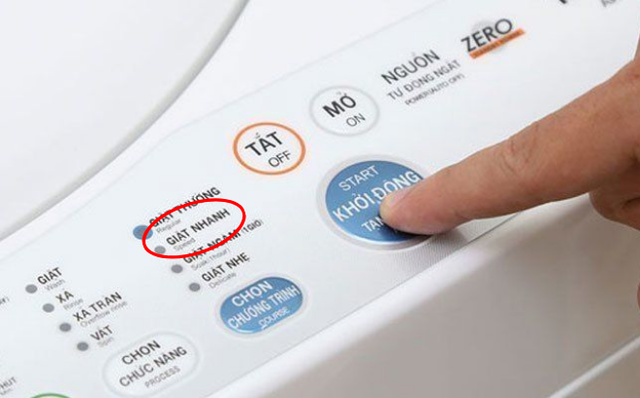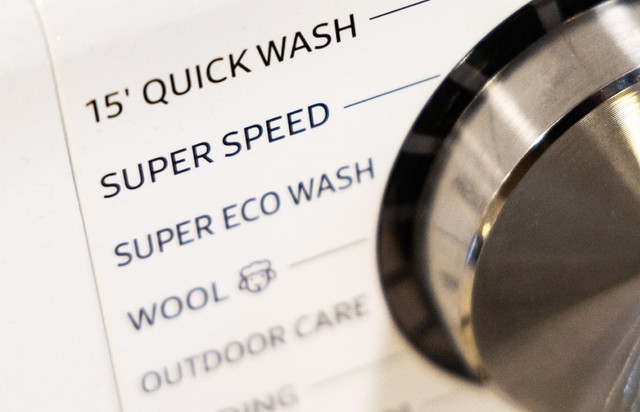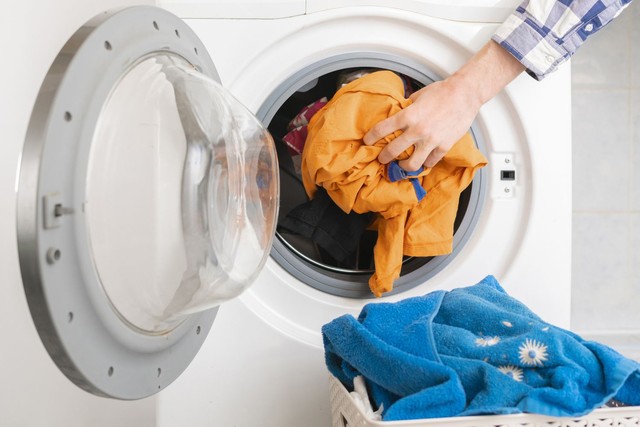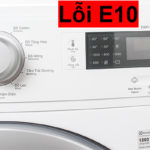Among the many innovative home appliances that have become indispensable in modern households, the washing machine stands out as a true time-saving and labor-reducing marvel. Not only does it simplify the chore of doing laundry, but it also ensures a higher level of cleanliness and germ removal than handwashing could ever achieve.
Beyond the standard or regular wash cycles, washing machines often come with a range of additional modes. However, one such mode, while offering convenience and speed, also comes with certain caveats. Before making a choice, users should fully understand the characteristics of this mode: the Quick Wash.

Washing machine Quick Wash mode: fast and convenient, but with potential drawbacks (Illustrative photo)
What is Quick Wash and How Does It Work?
As the name suggests, the Quick Wash mode enables users to wash clothes in a significantly shorter time compared to the regular cycle. While a standard wash cycle typically involves a full sequence of washing, rinsing, and spinning, lasting around 45-60 minutes, the Quick Wash mode condenses this process to a mere 15-20 minutes.
The washing machine accomplishes this by minimizing the number of wash and spin cycles, performing only the essential steps. Different washing machine brands may use different designations for their Quick Wash modes. Examples include 15-Minute Quick Wash, Quick 30, Speed14, or Quick 18.

Illustrative photo
Consequently, this mode is ideal for individuals who are pressed for time and seek a speedy laundry solution. Additionally, due to the shorter duration, Quick Wash consumes less water and electricity. This economy has led many users to deem it more cost-effective than the standard wash cycle. By minimizing the machine’s agitation and spin cycles, Quick Wash also exerts less wear and tear on garments. As a result, it is often considered a gentler option that can help preserve fabrics.
Despite its advantages, notably its speed, convenience, and efficiency, the Quick Wash mode on washing machines does have some limitations that users should be aware of.
Drawbacks of Quick Wash
As mentioned earlier, due to the abbreviated wash time and reduced number of steps and operations, the Quick Wash mode has an inherent limitation: IT IS NOT SUITABLE FOR HANDLING LARGE LOADS OR ITEMS WITH HEAVY STAINS, ODORS, OR SET-IN DIRT.
According to information from Cleanpedia – a dedicated website from Unilever – Quick Wash delivers optimal results, meaning effective cleaning, thorough rinsing, and adequate drying, only when dealing with small to medium loads (approximately 2-3 kg, less than half the capacity of most washing machines) that are relatively free of stains or unpleasant odors.

Quick Wash mode is only suitable for small loads with minimal stains or odors (Illustrative photo)
Employing Quick Wash for larger loads with significant stains and odors will likely compromise the machine’s ability to effectively clean them. Clothes may not be thoroughly washed, odors may persist, and excessive detergent use could result in detergent residue clinging to the garments, potentially causing skin irritation.
Therefore, before using the Quick Wash mode on their washing machine, users should carefully consider the size and condition of their laundry. If the load meets the criteria, Quick Wash can be a viable option. However, if garments have particularly challenging stains or odors, it is advisable to opt for a standard or regular wash cycle.
Different washing machine brands and models may have specific guidelines for their Quick Wash modes. It is recommended that users consult the manufacturer’s instructions before using this feature. For example, Samsung’s Quick Wash mode is designed for loads under 2 kg and requires less than 20 g of detergent. Electrolux’s Quick Wash mode is ideal for synthetics and mixed fabrics, with a water temperature below 30 degrees Celsius. LG’s Quick Wash mode is suitable only for lightly soiled or sweaty garments, such as workout clothes.

Before using Quick Wash, familiarize yourself with the mode’s specifications for your particular washing machine model (Illustrative photo)
By carefully reading the instructions and using Quick Wash appropriately, users can maximize its benefits and enjoy its convenience.






































